Following the easing the travel restrictions after the Covid pandemic, tourism in Vietnam has seen a major augmentation according to statistics and the these are the amazing tourist sites or attractions you should visit in Vietnam.
Is Vietnam good for tourism?
Vietnam is a Southeast Asian country that widely embraced for its beaches, rivers, Buddhist pagodas and bustling cities. Hanoi, the capital, pays homage to the nation’s iconic Communist-era leader, Ho Chi Minh, via a huge marble mausoleum. Ho Chi Minh City (formerly Saigon) has French colonial landmarks, plus Vietnamese War history museums and the Củ Chi tunnels, used by Viet Cong soldiers.
This unique tourist places that is blend of nature and culture make Vietnam a good place for tourism not only for solos and adults but also for the family as a whole.
Places to visit in Vietnam with things to do
For tourists, the following attractions from the Vietnam tourism industry are the favorite in Vietnam that you must see as a first timer on your visit to the Asian country.
- Ha Long Bay
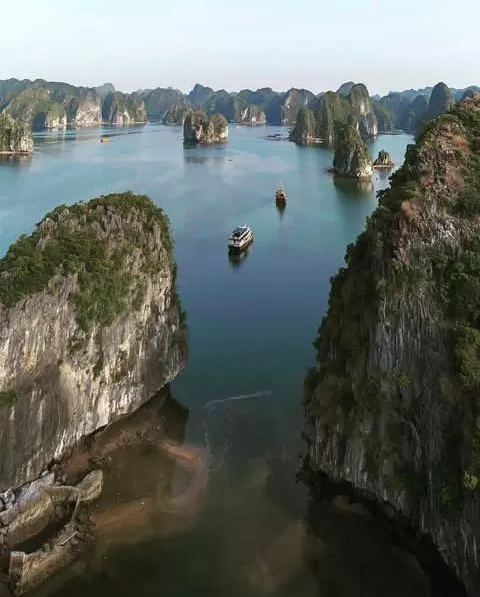
The Halong Bay is one of the amazing tourist attractions in Vietnam. Being a UNESCO World heritage site located in Vietnam, the karst seascape of Halong Bay is one of the best places to visit in the world for spellbinding sea views. Thousands of limestone islands sit within this bay in the Gulf of Tonkin eroded into jagged pinnacles by wind and water action over millennia.
The bay has an area of 1,553 square kilometers which is made up of 1,900 large and small limestone islands in vivid shapes. Ha Long Bay in Vietnam has been recognized as a natural wonder of the world many times by UNESCO and is known as a must-visit place once in a lifetime.
It has a beautiful bay’s scenery best seen by boat, this is prime cruising territory. There are plenty of caves in the bay that can be entered including the Hang Sung Sot, with three mammoth caverns, and the Hang Dao Go, with superbly weird stalagmites and stalactites. For most people though, the highlight is simply cruising amid the karsts and soaking up the changing scenery of pinnacles as you pass by.
2. Thien Mu Pagoda in Hue

Thien Mu Pagoda (namely Heaven Fairy Lady Pagoda), also known as Linh Mu Pagoda, is one of the most fascinating and ancient Pagoda in Hue city. It is situated on Ha Khe hill, on the north bank of the Perfume River, in Huong Long village, 5 kilometers from Hue city, which is easy to reach from the city center.
The name of the pagoda derives from a special legend. Long time ago, an old woman appeared on the hill where the pagoda stands today, telling local people that a Lord would come and build a Buddhist pagoda for the country’s prosperity.
Lord Nguyen Hoang therefore ordered the construction of the pagoda the “Heaven Fairy Lady” or Thiên Mụ in Vietnamese (also called Linh Mụ). Thanks to such a mysterious history, the pagoda has attracted a great number of tourists from both inside and outside of the nation to come and explore the legend themselves.
The beautiful pagoda was built in 1601. Later on, several kings of the Nguyen Dynasty such as Gia Long, Minh Mang, Thieu Tri and Thanh Thai, all had the pagoda restored. At this very initial time, Hoang was the governor of the province of Thuan Hoa (now known as Hue), yet, started ruling his independent state in central Vietnam.
According to the royal annals, Hoang was on a sightseeing trip and holiday to contemplate the seas and mountains of the local area when he passed by the hill, which is now the site of the Thien Mu Pagoda. On hearing the mentioned local legend, he had the pagoda constructed. The initial temple was in a very simple form of construction, but as time went by, it has been redeveloped and expanded with more intricate features.
The most striking feature of the pagoda, Phuoc Duyen tower (initially called Tu Nhan tower), was erected in 1884 by King Thieu Tri, and has become the unofficial symbol of Hue. This octagonal tower has seven storeys (2m high), which is dedicated to a Buddha who appeared in human form.
It is the highest stupa in Vietnam and is often the subject of folk rhymes and cadao about Hue, such is its iconic status and association with the city. More importantly, it is regarded as the unofficial symbol of the former imperial capital.
The site opens daily from early in the morning till 5PM. It’s suggested that tourists should come here early in the morning to see the fresh beginning of daily activities in the pagoda, or at sunset when the sky and the river combines to create a picturesque scene.
On special occasions such as 15th of April and July of Lunar Calendar or at Tet Holiday, the pagoda is more crowded and has several unique ceremonies that visitors may be interested in. These are also the time when visitors can have the most traditional and delicious vegetarian food in the city. Tourists can freely join these meals.
Today, the pagoda is surrounded by flowers and ornamental plants. At the far end of the garden stretches a calm and romantic pine-tree forest. It is much well-maintained and very welcoming to all visitors.
3. Hoi An
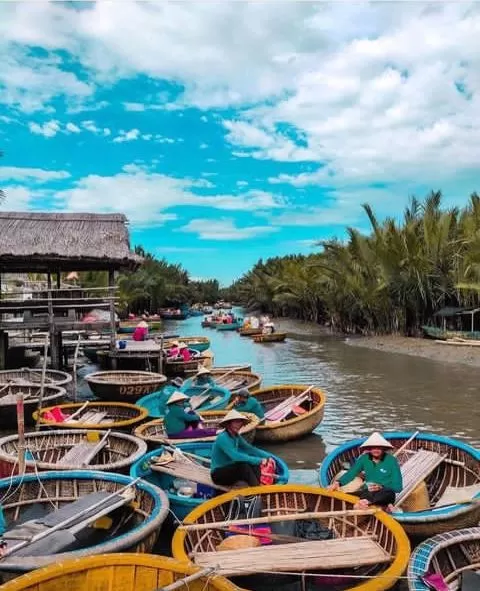
Hoi An Ancient Town is an exceptionally well-preserved example of a South-East Asian trading port dating from the 15th to the 19th century. Its buildings and its street plan reflect the influences, both indigenous and foreign, that have combined to produce this unique heritage site.
Hoi An can be located in Vietnam’s central Quang Nam Province, on the north bank near the mouth of the Thu Bon River. The inscribed property comprises 30 ha and it has a buffer zone of 280 ha. It is an exceptionally well-preserved example of a small-scale trading port active the 15th to 19th centuries which traded widely, both with the countries of Southeast and East Asia and with the rest of the world. Its decline in the later 19th century ensured that it has retained its traditional urban tissue to a remarkable degree.
The town reflects a fusion of indigenous and foreign cultures (principally Chinese and Japanese with later European influences) that combined to produce this unique survival.
The town comprises a well-preserved complex of 1,107 timber frame buildings, with brick or wooden walls, which include architectural monuments, commercial and domestic vernacular structures, notably an open market and a ferry quay, and religious buildings such as pagodas and family cult houses. The houses are tiled and the wooden components are carved with traditional motifs.
They are arranged side-by-side in tight, unbroken rows along narrow pedestrian streets. There is also the fine wooden Japanese bridge, with a pagoda on it, dating from the 18th century. The original street plan, which developed as the town became a port, remains.
It comprises a grid of streets with one axis parallel to the river and the other axis of streets and alleys set at right angles to it. Typically, the buildings front the streets for convenient customer access while the backs of the buildings open to the river allowing easy loading and off-loading of goods from boats.
The surviving wooden structures and street plan are original and intact and together present a traditional townscape of the 17th and 18th centuries, the survival of which is unique in the region. The town continues to this day to be occupied and function as a trading port and centre of commerce.
The living heritage reflecting the diverse communities of the indigenous inhabitants of the town, as well as foreigners, has also been preserved and continues to be passed on. Hoi An Ancient Town remains an exceptionally well-preserved example of a Far Eastern port.
Hoi An Ancient Town has retained its original form and function as an outstanding example of a well-preserved traditional South East Asian trading port and commercial centre. It remains complete as a homogenous complex of traditional wooden buildings, with the original organically developed street plan, within the town’s original river/seacoast setting.
These original cultural and historic features demonstrate the town’s outstanding universal value and are present, well-preserved, and evident within the boundary of the inscribed property, even while it continues to be occupied and function as a trading port, as well as a popular tourism destination.
As a result of this economic stagnation since the 19th century, it has not suffered from development and there has not been pressure to replace the older wooden buildings with new ones in modern materials. This has ensured that the town has retained its traditional urban tissue and is preserved in a remarkably intact state.
Hoi An Ancient Town has retained its traditional wooden architecture and townscape in terms of plot size, materials, façade and roof line. Its original street plan, with buildings backing on to the river, with its infrastructure of quays, canals and bridges in its original setting, also remains. The historic landscape setting is also intact, consisting of a coastal environment of river, seashore, dunes and islands.
Because most of the buildings were constructed in wood it is necessary for them to be repaired at intervals, and so many buildings with basic structures from the 17th and 18th centuries were renewed in the 19th century, using traditional methods of repair. There is currently no pressure to replace older buildings with new ones in modern materials such as concrete and corrugated iron.
Hoi An Ancient Town was classified as a National Cultural Heritage Site in 1985 and subsequently as a Special National Cultural Heritage Site under the Cultural Heritage Law of 2001 amended in 2009. The entire town is State property and is effectively protected by a number of relevant national laws and governmental decisions, such as: the Cultural Heritage Law (2001, amended 2009) and the Tourism Law (2005).
The 1997 Hoi An Town Statute defines in regulations that are implemented by the Hoi An Center for Monuments Management and Preservation, the responsible agency of the People’s Committee for the management of the property. Day-to-day management involves collaboration with various stakeholders, to maintain the authenticity and integrity of the property and to monitor socio-economic activities within and adjacent to the property.
The capacity of the professional staff has been and continues to be developed by many domestic and international training courses. Revenue from entrance tickets is invested directly in the management, preservation and promotion of the property. Management and preservation are further strengthened through master planning and action plans at the local level. There are also regular restoration and conservation programs.
Multi-disciplinary research conducted by teams of international and national scholars has informed the conservation and interpretation of the town’s heritage. This research is on-going. Within the property boundary, the landscape, the townscape, the architecture and all material cultural artifacts are preserved.
A Management Plan was implemented at the time of nomination of the property, and is being kept up to date and reviewed as required by UNESCO to ensure that it remains effective.
The buffer zone is managed to protect the property from external threats. The potential adverse effects to the property caused by annual flooding and urbanization are being effectively controlled with the active participation of all authorities and the local community.
The Master Plan for the Hoi An Ancient town conservation, restoration and promotion together with the city and tourism development was approved by Prime Minister on 12 January 2012, covered the period until 2025.
Long-term management should aim to promote improvement in the living conditions for local residents. As tourism increases a strategy to manage it within the parameters of the site will be required. Strategies to deal with adverse effects of the climate are being developed and should be included in the Management Plan.
In the future, it is an aim to link the Hoi An Ancient Town with the adjacent UNESCO Cu Lao Cham Biosphere Reserve and to build Hoi An into a community integrating ecology, culture and tourism.
4. Phu Quoc
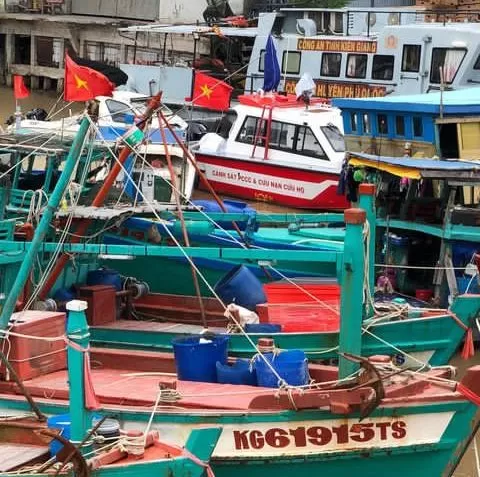
One of Vietnam’s most popular holiday destinations, Phu Quoc Island rises from the country’s slender southern tip like a genie released from a bottle. Its soft-sand beaches, swaying palms and limpid waters have been casting spells on visitors ever since its tourism potential was finally realized in the late 1990s.
Phu Quoc Island is the largest Vietnam Island and is part of Kiên Giang Biosphere Conservation Area that has been inserted in 2006 by UNESCO as a World Biosphere Reserve. District of Phu Quoc includes 28 islands with a total area of 593 square kilometres and Phu Quoc is the largest one.
Duong Dong is the largest town on the island. The economy is developed on tourism, fishing and agriculture. All foreign tourists are allowed from March 2014 with a visa free up to 30 days. Phu Quoc has white sand beaches and still dense undeveloped jungle.
Beyond the long beach where you can find most accommodation in Phu Quoc there is also undeveloped area so you can for sure relax and feel in peace!!! You can enjoy white beaches do snorkeling, run motorbike to explore the island. The rainy season is from May to October, while the peak season is from April to May and the best period to visit Phu Quoc Island is from November to March when the temperature is good on about 30 degrees.
Tropical Paradise of Phu Quoc Island is the largest Vietnam Island, situated in the Gulf of Thailand, 50 km from the Vietnamese mainland and a 50 minute flight from Ho Chi Minh. Phu Quoc is famous for beautiul beaches and many activities available as snorkeling, scuba diving, bird watching, hiking, fishing, trekking and untouched environment.
On the island you also can enjoy with golf courses, safari zoo and amusement park!!! Phu Quoc attention is focused on the national park that covers more less 70 % of the island, to protect the marine environment where you can enjoy and relax with many experience and tours. One of the best activity in phu Quoc is the most simple as watch the sunset!
Also, you can have an amazing taste of Vietnamese Cuisine, also visit historic prisons and temples. If you are searching for some shopping, just go to Dinh Cau Night Market that infact is a popular place for shopping and fresh seafood and taste lemongrass crab, kebobs or grilled oysters!!!
Phu Quoc is also famous for his black pepper and fish sauce, while being not part of Mekong Delta, is not the right place to produce rice. So, the Black pepper is considered one of the best peppers in the world that is coltived in Koh Rong in the center of the island. About fish source, if you are in Phu Quoc, you must visit one of many fish sauce factory. This fish sauce has been classified PDO, Protected Designation of Origin in the European Union!
Phu Quoc Island is the perfect place for western tourists that want to escape from occidental routine! The long beach and Bai Truong are the most developed area with many resorts, and no problem here with WiFi; but the rest of the island is still undeveloped, and you can enjoy exploring it! Phu Quoc offers diving on reefs, kayak, relaxing with massage or enjoy your taste with fresh seafood and absolute relax on white sand beach in Phu Quoc!
If you need an hospital, you can find it in Duong Dong, but they only speak Vietnamese so maybe you could need to go to Ho Chi Minh that is better for facilities as for the language but also if you have something serious.
If you want to discover and explore more Phu Quoc Island, the best way is chosen for Motorbike Rental and price are in general between 150,000 to 200,000 VND per day. We suggest that you take some pictures to scapes and dings, before to start your ride with the motorbike, as they could try to charge you for damage you not done, but already done!
So, if you take pictures before you’ll have proofs of pictures with date and time! Anyway, choose to explore the island with a motorbike is a good idea as roads are good paved and there are not much traffic and you can reach abandoned beaches, visit local villages or see wild monkeys on their habitat.
Beaches in Phu Quoc are very beautiful there are dozen bay and beaches. You can relax on some white sand or yellow sand, so just choose the best one for you! One of the best beaches in Phu Quoc is Sao Beach with white sand, warm and clean water and a perfect breeze.
Accommodation in the area is for any pocket, so ideal for backpackers or for luxury resorts and hotels or for a middle way!
If you have the possibility to book your next holidays to visit and relax in Phu Quoc now, you are lucky because it’s still undeveloped, so not wait too much as in future could become for example like Phuket!
You can drive through the island from north to south by roads in just one hour or less.
5. Sa Pa Terraces
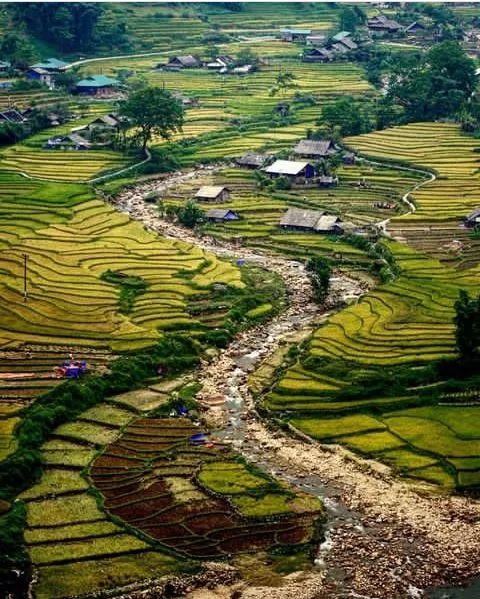
Immerse yourself in the stunning scenery of rural Vietnam: trek through the lush rice terraces of Sapa and discover the area’s secrets with an expert local guide.
On the morning of your hike, you’ll meet your guide in the centre of Sapa, in front of the Notre Dame Cathedral, ready to delve into the countryside. From here, you’ll begin trekking through the terraced rice fields of Northern Vietnam, an unforgettable experience that will allow you to connect with the daily life of the locals and with the dramatic mountainous landscape.
The guide will take you along a hiking trail which traverses the most spectacular sights in Sapa, and you’ll have the opportunity to see places well off the beaten tourist track.
Trek over the mountains between the verdant rice paddies, and discover panoramic viewpoints, waterfalls, forests and tiny rural houses hidden in the hills.
Experience the natural beauty of Sapa and its surrounding area in a unique way, accompanied by an expert English-speaking guide who will show you the region’s hidden secrets.
At the end of your trek through the rice terraces, after about six hours of walking, you’ll be taken back to Sapa bus station.
6. Mui Ne
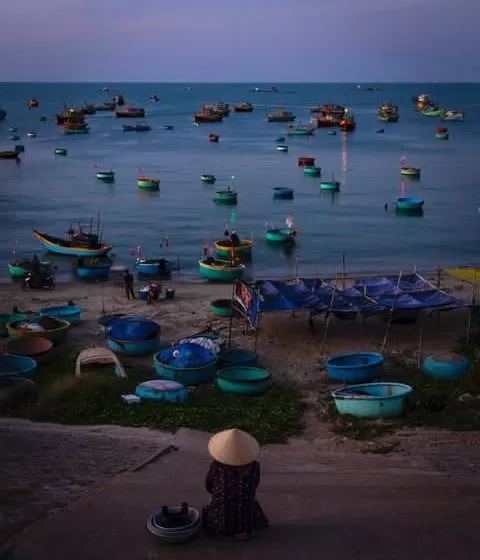
Located at the southern end of Vietnam’s enchanting eastern coastline, Mui Ne is the last coastal outpost before the chaos of Ho Chi Minh City. Sitting modestly just four hours outside of the hustle and bustle, Mui Ne is, without a doubt, the angel on the shoulder of Saigon. Laidback vibes pour from the heart of Mui Ne as it boasts the capacity to offer a little bit of fun for everyone.
Backpackers travel in droves to ogle at the famous white sand dunes. Sports enthusiasts flock to the ocean to try their hand at kite surfing, and city slickers hole up in the trendy beachside resorts, escaping the bedlam of Ho Chi Minh.
Mui Ne hosts an abundance of classy and comfortable resorts overlooking its fantastic coastline. It also houses a host of super cheap hideaway backpacker hostels and budget guesthouses for travelers seeking a more rustic experience.
This hostel is ridiculously good value for money for budget backpackers with beds from just $2.5 US per night! (No wonder Vietnam was voted the cheapest country to travel in SE Asia!) The hostel has five (yes, five!) outdoor swimming pools with beautiful views over the sea and plenty of fun nightly activities to get involved in, like beer pong, limbo and pillow fights! (Read more about that in our article here!)
The accommodation is actually made up of four separate hotels (Mui Ne Hills Budget Hotel, Mui Ne Hills Villa Hotel, Mui Ne Hills Bliss Hotel and last but not least, Mui Ne Hills Backpackers!). Their idea is to cater for every type of traveller in one place from backpackers, to flashpackers, to couples and those looking for more luxury. If you want a bit of privacy, the double rooms at Mui Ne.
At Mui Ne, things that visitors can do include;
The white sand dunes have long been the most popular tourist attraction in Mui Ne, and for good reason! Imposing dunes encapsulate the entire landscape making you feel like Laurence of Arabia wandering through a desolate corner of the Sahara.
For the complete experience, it’s possible to visit the sand dunes at sunrise, when the spectacle of the rising sun creates an awe-inspiring view. The sand, untouched at this early hour, welcomes your footsteps on its soft, cool surface. As the sun rises, find your own spot in the deserted dunes and watch as the morning rays dance across the landscape. It’s well worth getting there early to cement a prime spot atop an empty dune and capture those all-important pictures and memories.
A couple of tourists jump above the sand at sunrise at the white sand dunes, Mui NeYou can’t help but jump!
Visitors will undoubtedly be offered the chance to hire a quad bike or kneeboard on arrival at the dunes. During the day this experience is great fun as the dunes offer copious amounts of open space to let loose. However, avoid the temptation at sunrise as the quad bikes prove only to become an ambience-killer and will limit your time to enjoy the beautiful sunrise.
The significantly less impressive red sand dunes sit directly next to the coastal road running out of Mui Ne. The rusty red dunes are indeed a spectacle but have unfortunately become a tourist trap. The dunes are crowded and overrun with friendly ladies trying to sell kneeboards. It’s pretty much impossible to get a clear picture of the surrounding landscape. They are worth a quick stop, but not a place to linger too long.
On the winding coastal road out of Mui Ne, you’ll come across a steep concrete verge which, from a distance, looks like exactly that, a concrete verge. However, step towards the edge of this imposing coastal drop and absorb the impressive panoramic view of the fishing scene below. At the foot of the drop, old fishing boats decay gracefully under the sun whilst out in the bay an armada of fishing vessels float patiently on the calm water.
Fishing boats on the beach at Lang Chi Fishing Village Fishing boats on the beach at Lang Chi Fishing Village.
Take a walk on the beach where the industrious workers sort frantically through the day’s catch. The scene on the sand is an assault on the senses. The smell of fish, both fresh and rotting is, unsurprisingly, overwhelming. Powerful colors dominate the shoreline.
Ladies, brightly dressed, crouch down to inspect the catch and even litter finds a suitable home in the chaos of the sand. If you eat seafood during your time in Mui Ne, it probably came from here. To really appreciate one of Vietnam’s most prominent industries, it’s well worth watching the melee of where your dinner came from.
Fishermen and local ladies go through the catch of the day at sunset in Lang Chi Fishing Village, the hustle and bustle of the fishing industry.
Hidden comfortably down an inconspicuous alleyway, the concealed entrance to Mui Ne’s beautiful Fairy Spring protects its integrity from the masses. Leave your shoes behind and step carefully into the shallow stream carved out between the dunes.
The stream flows slowly and leads you on a delightful stroll through this striking landscape. At times the dunes become as high as canyons, towering impressively above you as you wander aimlessly onward.
A brown water stream runs between white and red cliffs on the left and luscious jungle green on the right at Fairy Spring (Suoi Tien)The Fairy Spring (Suoi Tien), Mui Ne.
For the best view of the surrounding landscape, it is possible to scale the side of a lung-busting dune and ogle from the top at the scene beyond. The golden sand and deep green trees clash to form a magical clash of color.
The stream, to my knowledge, doesn’t lead anywhere in particular. But just to experience the landscape and possibly meet some friendly faces along the way makes a stroll through the stream a necessity for any trip to Mui Ne.
Both the above are extremely popular in Mui Ne and with these trendy sports comes the inevitably cool, laid back vibe as surfer types play on the beach in the day and chill in the bars at night. For those wanting to try the sports for the first time, lessons are available but they can be pricey.
On the whole Mui Ne is as laid back by night as it is by day. Restaurants ranging from traditional Vietnamese to Indian and even German food scatter along the quiet strip. It’s best to eat early as the restaurants won’t stay open much after 10 pm.
Many visitors choose to eat at their beachside resorts and so the main strip will never really be bustling in the evening. With the constantly changing outlook of Mui Ne’s laid-back atmosphere, the best way to find a nightspot is to ask around. That said, here are a few of the more popular spots at the moment…
Mad Monkey Backpacker Bar, located on the premises of the popular hostel Mui Ne Hills Backpackers, has become the main place for backpackers to hang out at night in Mui Ne. (Listed number one on Trip Advisor for nightlife in Mui Ne.) If you’re not a guest at Mui Ne Hills, don’t worry, you can still head there in the evening to party! As well as a swimming pool, a lively bar and DJ sets, they’ll soon be opening a dance floor with a chill-out zone and even a jacuzzi!
At Joe’s Cafe, live music is the order of the day, with live acts playing most nights from 7:30 pm onwards. Here you’ll tend to find a big crowd of ex-pats attracted by the impressive food and drinks menus.
7. Mekong Delta
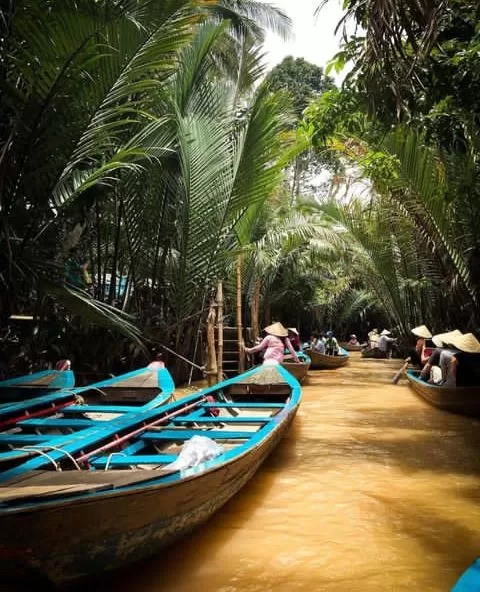
In Southern Vietnam, the Mekong Delta is home to myriad attractive destinations and unique ecosystems that deserve more than a day trip from Ho Chi Minh City.
The River Mekong unravels into nine rivers, creating the fertile Delta as nowadays. Daily life in the delta flows with the ever-changing waters, rice fields are dug as the waters recede and fisheries thrive throughout the annual flood. Considered as the “Rice bowl” of Vietnam, Mekong Delta River brings the magic inside that appeals to all those who have come to this immense land.
The Mekong Delta is completely focused around the water, which explains why the only way to navigate this region is by boat. You will see rice paddies, fruit orchards, and floating markets, Buddhist temples and family houses clinging to the river’s banks.
The Mekong Delta is considered “the rice bowl of Vietnam”. It yields a large amount of fresh produce for the country. During the trip to this region, you will see flourishing agricultural trade at one of the most famous floating markets – Cai Rang. This floating market is a magnet for tourists with cameras.
Cai Rang floating market is one of the biggest ones in Vietnam, which is about 6km from Can Tho. Boats are filled with fresh watermelons, tiny dugouts carry pigs, and barges overflow with pineapples. The local hawkers with conical hats on their heads yell their prices whilst packing greasy foil packets. A Cai Rang appears in front of travelers authentically like that.
Coming here early in the morning will give you a chance to see the best of the market. For the best vantage point, you can make use of a traditional boat to go through the market, and watch locals trading the produce with each other.
As a major transshipment point, Vinh Long has many geographical advantages over other areas of the Mekong Delta. This is the place connecting the mainland with the offshore islands of Vietnam. Surrounded by rivers and canals, households in Vinh Long can take advantage of the flow to earn their livelihood. Currently, many local families in Vinh Long welcome visitors, giving them the opportunity to experience local life in the most authentic way.
The houses are located right by the river, surrounded by orchards laden with tropical fruits. You will be provided with a basic but separate, clean, private room to stay during the days you stay here. Enjoying local meals with the hosts and observing the daily life and listening to them share about culture, cuisine this is really not an easy-to-find experience for any tourist when visiting Vietnam.
Sa Dec port used to be a stop for long cruises and was also the former patrol base for the US. Today, Sa Dec port is a bustling commercial port, but only receives a moderate amount of visitors because it is oriented to maintain the local feel.
It has tree-lined streets, houses with French-styled terraced architecture with pastel-colored facades. One of the most impressive houses is the Huynh Thuy Le Old house, once the residence of a wealthy Chinese family. Huynh Thuy Le is the son of the family, he fell in love with the French writer Marguerite Duras, and he was the one who inspired her to write the famous autobiography The Lover.
Although this place is just modestly located next to the busy river, it provides locals and travelers with a variety of rich fruits and vegetables.
Chau Doc is a busy town bordering Cambodia. The telltale sign of this town is Sam Mountain rising up in the middle of green rice fields. Although only 182m high, this small mountain still dominates a large flat landscape. Climbing to the top of the mountain, you can admire the entire delta to Cambodia.
Since the main religion is Buddhism, along the way you will find brightly painted temples and tombs.
On the way to the top of the mountain, you will see a trail of dinosaurs made of ceramic. On the peak, there is a watchtower made of tin, where the Vietnamese army monitors the border with Cambodia.
If you want to watch Chau Doc sunrise on the mountain peak, rest assured that along the way, it has been lit up to help you climb the mountain easily. After the sunrise experience, you can have breakfast at the small eateries along the way to refuel before going down the mountain.
Barges that were once used to transport rice have now been converted to carry tourists. A good example is the Bassac fleet, which has been converted into a cruise for tourists to travel along the Mekong Delta for one or two nights. With this barge, you can observe the lives of local people passing by very realistically.
On the barge, there are many finely sculpted handmade vessels. The comfortable cabins are decorated with unique local textiles. As the cruise travels along the river, you’ll see local villages and floating markets, and your on-board guide will also explain the history of rice barges that appeared frequently along the route.
Located in A Giang territory of the Mekong Delta, Tra Su Mangrove Forest is a forested area characterized by almost year-round dryness. The most suitable time to admire the forest’s beauty is at the end of the year, amid the sunny season, when the water level rises and the territory transforms into overwhelmed woods, which is very convenient for tourists to enjoy the scenery on the watercraft. The most beautiful month of the year is from September to November.
Tan Lap floating village is a famous ecotourism site in the Mekong Delta. This place is a flooded forest, located deep inside the heart of Dong Thap Muoi. Covered by a cool green forest system, you can visit the floating village at any time of the year, but the most beautiful time is the floating season from August to November. This time witnesses the vigorous growth of both fauna and flora, blooming lotus ponds with sweet fragrance. For an extra USD2.5, tourists can stroll on the lifted path through cajuput backwoods or take a boat along the channel.
The best time to travel to the Mekong Delta is from October to March, when the river water level is highest, ideal for boat markets and sailing trips. This is also when life on the river becomes the busiest. January to March offers the best weather in the whole of Vietnam, despite prices being quite high at this time due to the recent Lunar New Year and shops and restaurants closed for a few days.
8. Cu Chi Tunnels
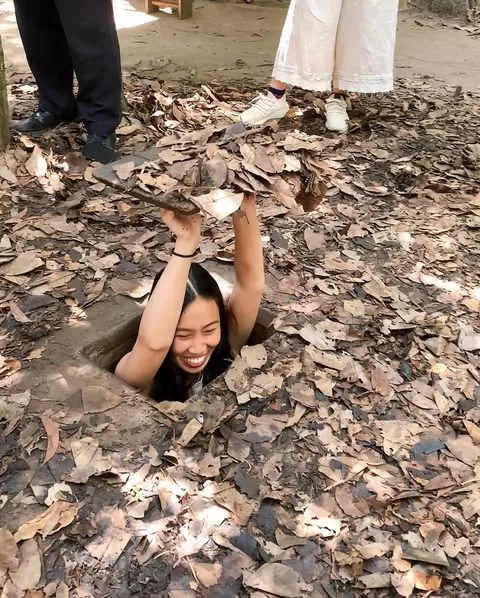
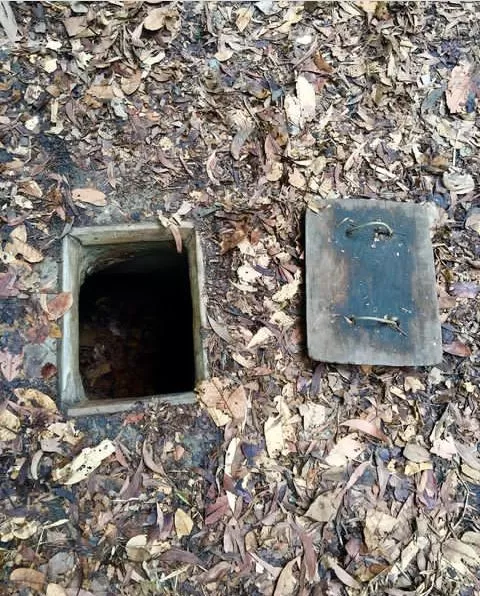
Cu Chi Tunnels of Sai Gon are honored in the TOP 7 most adventurous destinations in Southeast Asia and TOP 12 most attractive underground wonders in the globe. The decades-old tunnel complex resembles a sophisticated hidden maze, where visitors can glimpse the turbulent Vietnamese history as if they are traveling back to the wartime.
Cu Chi Tunnels (Địa đạo Củ Chi in Vietnamese) are situated in Cu Chi district – the outskirts northwest of Ho Chi Minh city, 70 kilometers away from the city center. The underground networks are well-retained in two spots: Ben Dinh Tunnels (Ben Dinh Hamlet, Nhuan Duc Commune) and Ben Duoc Tunnels (Phu Hiep Hamlet, Phu My Hung Commune).
The Tunnels of Cu Chi, a gigantic underground tunnel system, was originally constructed under the jungle terrain, connecting tunnels among the hamlets and communes during the Indochina war (1945-1954) against the French colonialists. It served as hiding spots for Vietnam revolutionary troops to discreetly commute between regions and evade French scouts.
During the Vietnam war, the network had been expanded into an assembly complex for Communist guerrilla soldiers to house troops, transport communications, and supplies, receive medical treatments, take shelters from aerial bombardment, and mount surprise attacks, after which they could disappear underneath the ground.
As a military headquarters, Cu Chi Tunnels played a pivotal role in the Vietnamese forces’ resistance to the American army in South Vietnam. It served as an isolated stronghold to plan strategies and launch successful military campaigns, notably the victorious Tết Offensive in 1968.
Besides the underground experiences, the Tunnels of Cu Chi afford exciting military sports that fascinate many foreign tourists. Both Ben Dinh and Ben Duoc have shooting ranges, allowing participants to handle weapons used during the war, such as AK-47s and M16s, under the staff’s instructions.
In paintball shooting, players will be equipped with masks, uniforms, armor, and guns for their combat in the natural forest. These war simulator games will help you experience the shooting, team collaboration, and fighting spirit as soldiers of the past.
9. Nha Trang
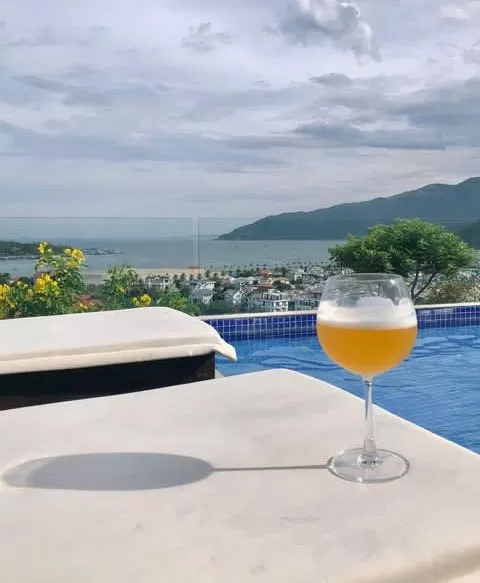
Nha Trang is a coastal city and a center of politics, economics, culture, science and technology and tourism of Khanh Hoa Province, Vietnam. Before becoming the land of Vietnam, Nha Trang belonged to Champa. Cham sites are still in many places in Nha Trang.
The city of Nha Trang is 1.280km from Hanoi, 448km from Ho Chi Minh City, 630km from Hue, 98km from Phan Rang, 220km to Mui Ne, 620km to Can Tho.
Nha Trang was officially recognized as a grade 1 city by the Prime Minister of Vietnam on 22 April 2009. It is one of the first class cities in Vietnam. Nha Trang has known as the jewel of the East Sea, the jewel of green because of its natural value, as well as climate.
Situated in the center of Khanh Hoa Province, in the north it borders on Ninh Hoa Town, Cam Ranh City in the South, Dien Khanh District in the South, in a mountain valley 3 in the North – West – South and adjacent to coast to the east. Nha Trang River and Cua Be River divide Nha Trang into 3 parts, including 27 communes and wards. Before becoming the land of Vietnam, Nha Trang belonged to Champa. The ruins of Chiem still exist in many places in Nha Trang such as Cham towers, Ponagar tower.
According to many researchers, the name “Nha Trang” was formed by the Vietnamese pronunciation of the Cham site, formerly Ya Trang (meaning “Lau river” via Nha Trang today). From the name of the river, after only expanded to land since 1653.
Apart from the heavenly beaches for swimming, Thap Ba Hot springs, Nha Trang has the colorful coral reef underwater. It offers the diversified kinds of fish and marine creatures. Nha Trang becomes one of the best spots for scuba diving and snorkeling. The city is one of the famous entertainment places like Vinpearl Land, Tri Nguyen Aquarium, Hon Tam Resort to get your leisure time.
Nowadays, visitors pay money for both travelling, relaxing and finding inner peace of mind. And Nha Trang, possesses many untouched nature places. They are potential for zentourism development such as Hon Ba, Suoi Do, Ba Ho and Van Phong Bay.
10. Phong Nha Caves
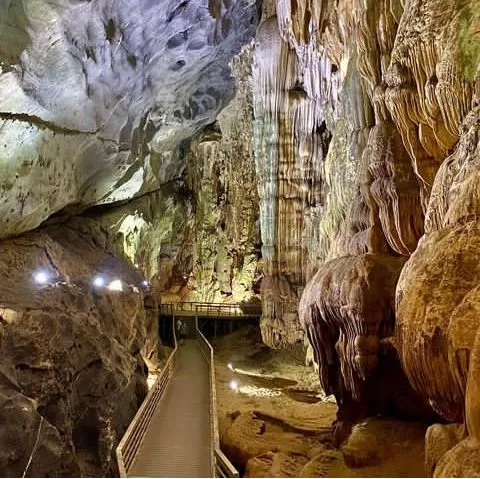
Phong Nha is an adventurer’s paradise. Millions of years of flooding have chiseled out the world’s largest caves, meandering rivers entwine ancient karsts, and jungle-clad mountains lend an otherworldly atmosphere.
Colossal caves may be the main draw, but linger a little longer and Phong Nha-Ke Bang National Park will reveal hiking trails, countryside lanes, and rivers perfect for kayaking. Although this is Vietnam’s top adventure destination, Phong Nha is still in the early stages of development. Now is the time to come. The caves are pristine, the locals are friendly, and you’ll feel like you have the wilderness all to yourself.
Caves in Phong Nha range from the tame to the tremendous. For conservation reasons, local authorities restrict access to the larger caves. Some tour companies have exclusive rights to take travellers inside certain caves, while others are open to all. Son Doong looms large as one of the world’s greatest natural wonders, but don’t let that overshadow the allure of Phong Nha’s other treasures.
The Tu Lan cave system lets you wade, swim, climb and crawl through a seemingly never-ending network of tunnels. If you enjoy floating down underground rivers and burrowing through tight passageways, this is the cave system for you. Tours of Tu Lan range from one-day moderate trips to full-on, four-day expeditions.
Famous for their striking stalagmites and picturesque rock pools, Hang Va and Nuoc Nut are ideal for a two-day tour. The trip is short but challenging, as you’ll need to navigate razor-sharp rocks and clamber over karst passes to access the caves. Hang Va is undoubtedly the highlight, especially from January to March when the rock pools are at their fullest.
Exploring Pygmy Cave, the world’s fourth largest, involves a challenging three-day expedition complete with abseiling and climbing. En route you’ll swim underground rivers in Tiger Cave and wade through jade-colored ponds in Over Cave. If you haven’t the time or budget for Son Doong, Pygmy Cave provides a great alternative at a fraction of the price.
Thank you for reading this article.
Related articles
13 Awesome Places To See With Things To Do In Phuket
18 Top Oldest Cities In The World To Visit
